Freiburg continue to defy the odds under Head Coach Christian Streich, and with the season postponed find themselves in eighth position in the Bundesliga table and just one point from a Europa League spot. Freiburg and Streich have made a reputation for themselves for consistently overperforming and finding great value for their money in transfers. Over the last three seasons, the likes of first-team regulars Vincenzo Grifo, Jonathan Schmid, Luca Waldschmidt, Dominique Heintz, Lucas Höler, and Janik Haberer have all been added to the side for a combined £19.9 million.
They have a habit for spotting talent and bringing them in cheap too. Both Philipp Lienhart and Luca Itter were brought in for cut-price fees, and there have been plenty of top-level talent that have been signed by Freiburg and later moved on. Gelson Fernandes, Zack Steffen, and Roman Bürki have all spent time under Streich, whilst Leicester regular, Çağlar Söyüncü was signed for £2.4 million and sold two years later for £19 million.
It seems the next centre-back to follow in Söyüncü’s footsteps will be Robin Koch. The 23-year old German centre-back, who is equally comfortable as a holding midfielder, was bought from Kaiserslautern for £3.6 million. RB Leipzig were rumoured to be very close to signing him in January, however, for whatever reason the move didn’t come to fruition. Yet, with just a year left on his contract, it is becoming ever more likely that Freiburg will look to cash in on the young defender, and there will surely be no shortage of suitors.
This scout report and tactical analysis will look at Koch’s qualities, how he fits in with Freiburg’s tactics, and what he could potentially bring to his next club side.
Defensively
Koch is strong all-around as a defender ranking 13th in the Bundesliga for defensive duel win percentage with 72.88%. He reads the game well and is rarely caught out of position, instinctively covering his centre-back partner whenever needed and not getting caught too far forward positionally in these instances. On top of this, he has enough pace at his disposal not to be out of his depth in a foot race against even the league’s quickest forwards.
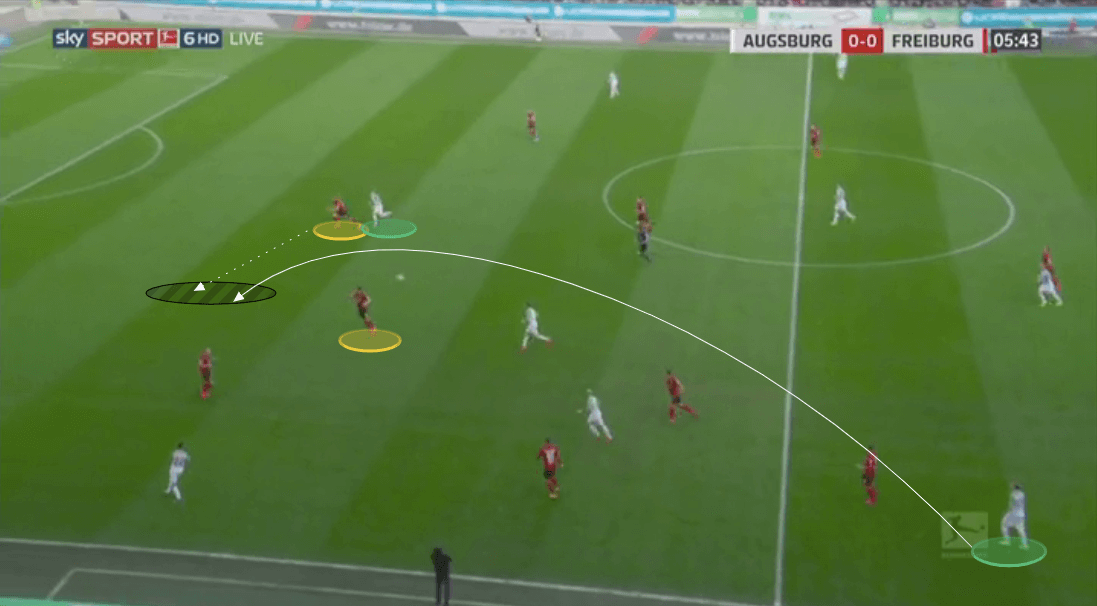
With such a strong defensive duel win percentage, Streich allows Koch to be aggressive at times with his defending, and as long as he is pushing his man backwards, Koch will happily follow the ball-carrier well inside the opposition half. He does get success from this, either winning the ball back himself or by pushing the opponent towards a teammate who can win it back, and as long as it’s not against a side with a front three, it’s safe to do. In the analysis below, we can see Hoffenheim have just one striker forward against three Freiburg defenders, as Koch pushes their second forward backwards and towards traffic.
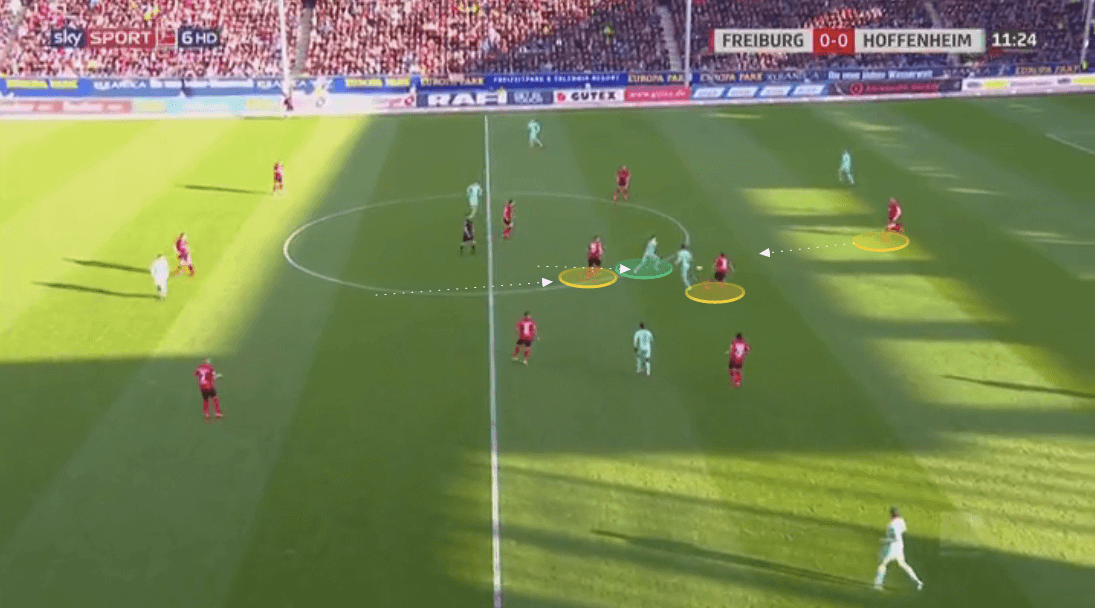
There’s an argument to be had that he could still benefit from developing a little physically. He is 1.9 metres tall but is very lean, and he has had issues against physical centre-forwards this season. This was most notable in the 4-0 loss against Köln earlier this season, where Köln centre-forward Jhon Córdoba gave him a difficult afternoon. Koch won just 17% of his aerial duels that day.
Koch is also prone to the odd error. His calmness on the ball can lead to him sometimes being caught in possession or making a stray pass. There have been costly momentary lapses of concentration too, such as the example below, where his missed clearance allowed Phillip Max to score for Augsburg in the 1-1 draw in February.
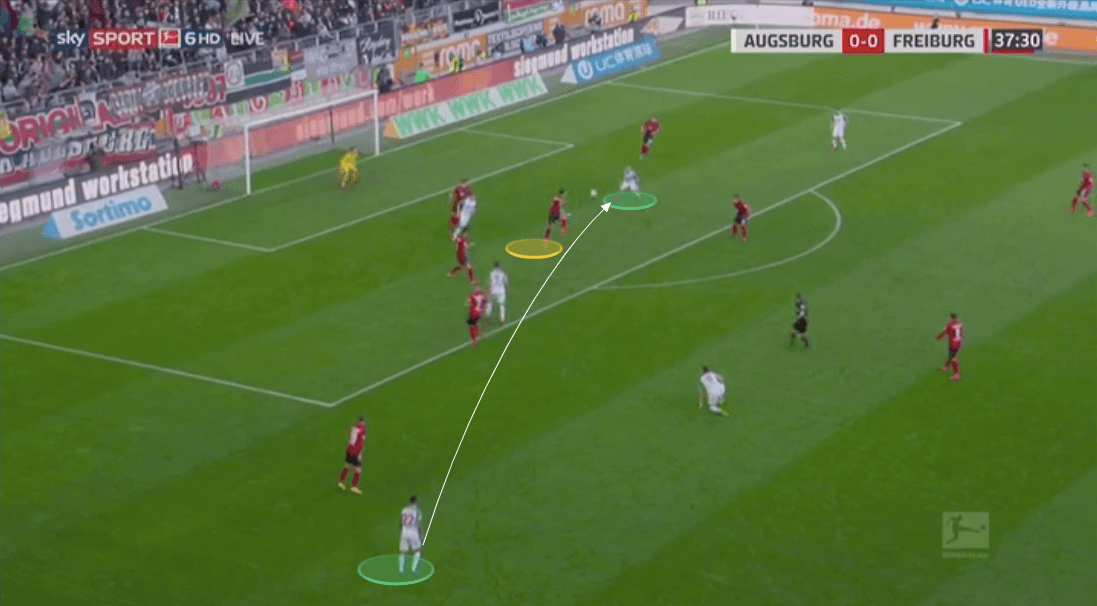
Versatility and pushing further forward
As mentioned, Koch can play in central midfield and is comfortable operating in higher areas, looking to pick out passes from deeper areas inside the opposition half like in the image below.
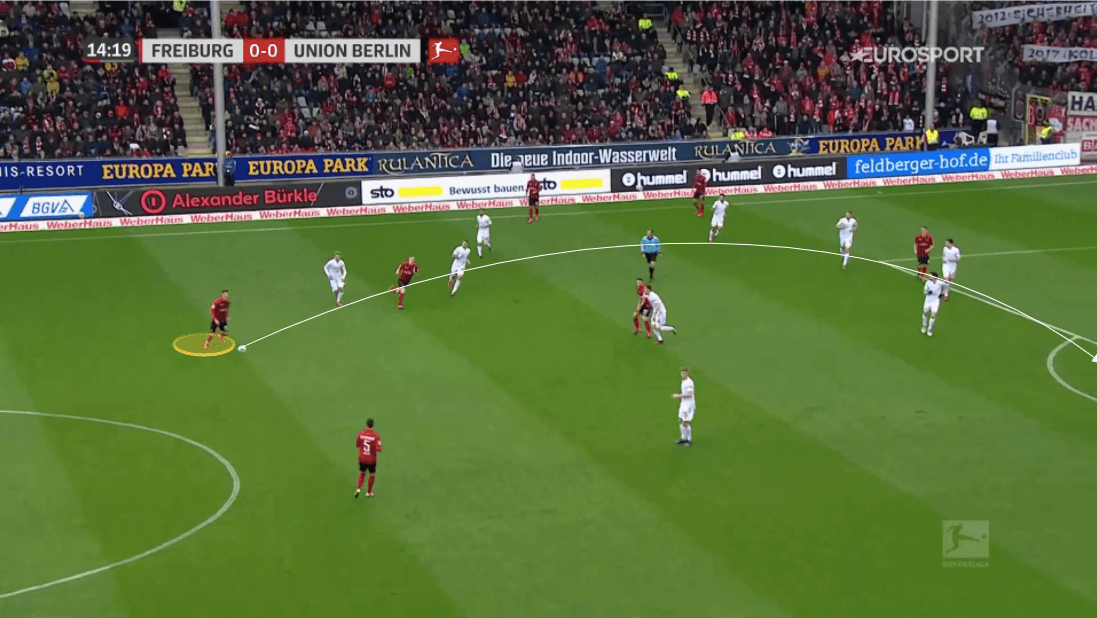
Koch generally plays as a ball-playing centre-back, and it’s easy to think of this type of player as a laid-back “Rolls-Royce” type of defender. Koch definitely has some of these qualities, but when out of possession, he shows the intensity and a desire to win the ball back as quickly as possible. When playing further forward, he doesn’t have to have quite the same positional discipline as at centre-back, and he adds good energy to the press in the middle.
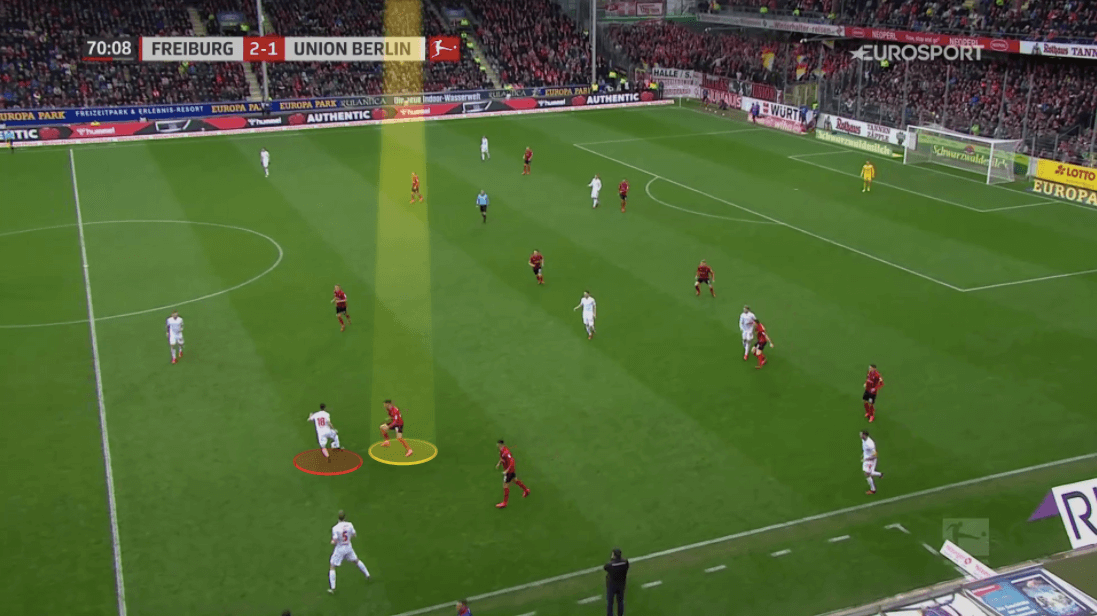
Despite this, his biggest strength as a player is his ability on the ball, specifically with his passing (which I will go into detail on shortly). As good as he is dictating the play from the back, it naturally makes sense to have a player with such passing ability to operate higher. Depending on the pace of the game, Koch will push into central-midfield positions even when playing as a centre-back. Below he was operating as part of a back three against Paderborn, however, decided to drift further forward and look to receive in midfield. He reads space well and will slide into the half-spaces to receive the ball past the first line of the press.
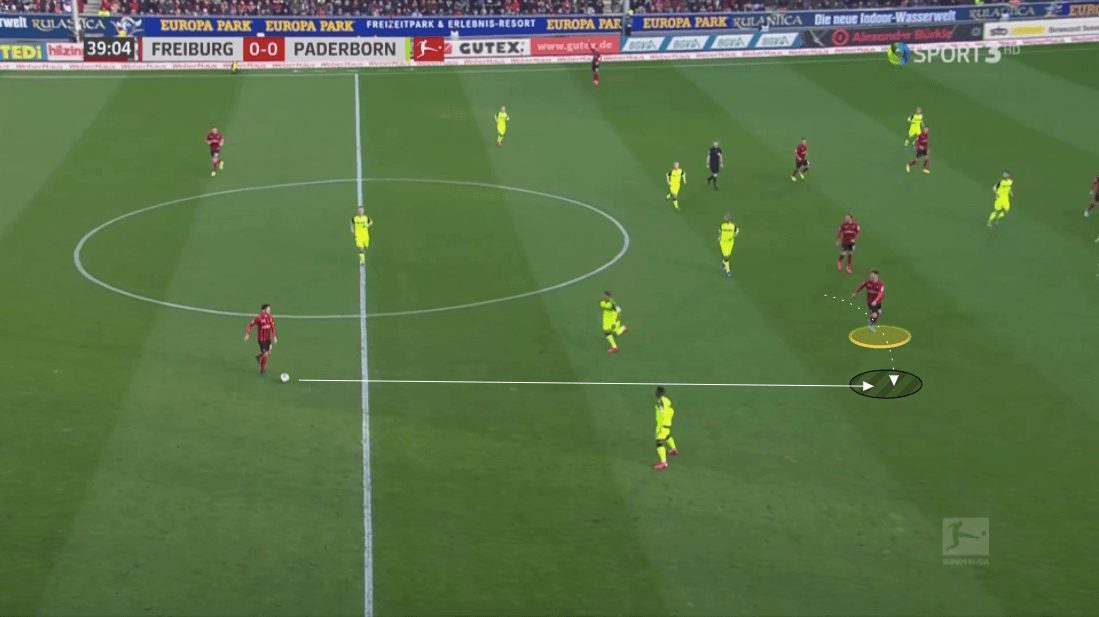
He is naturally attack-minded and is comfortable pushing even further forward too. Below we can see him laying the ball out wide to Schmid before continuing his run behind the Paderborn defence in order to receive the pass and make the cross from wide.
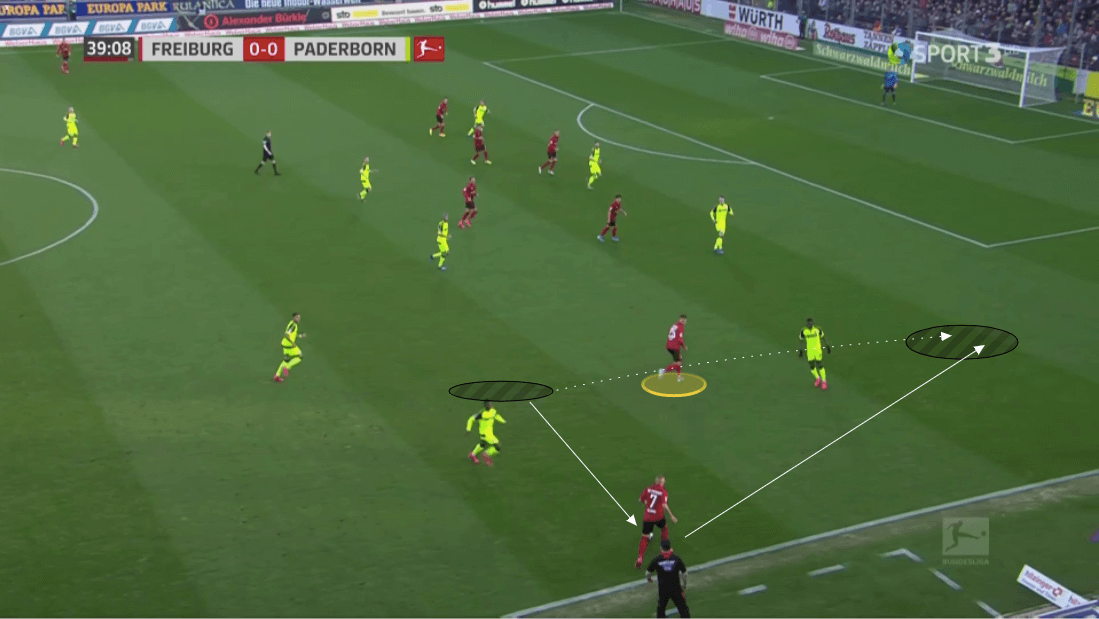
Regardless of how far forward he goes, Koch doesn’t neglect his defensive duties and consistently shows good stamina and excellent desire to get back and take a good defensive position behind the ball, such as in the image below, which is taken only 20 seconds after the image above of him getting behind to make the cross.
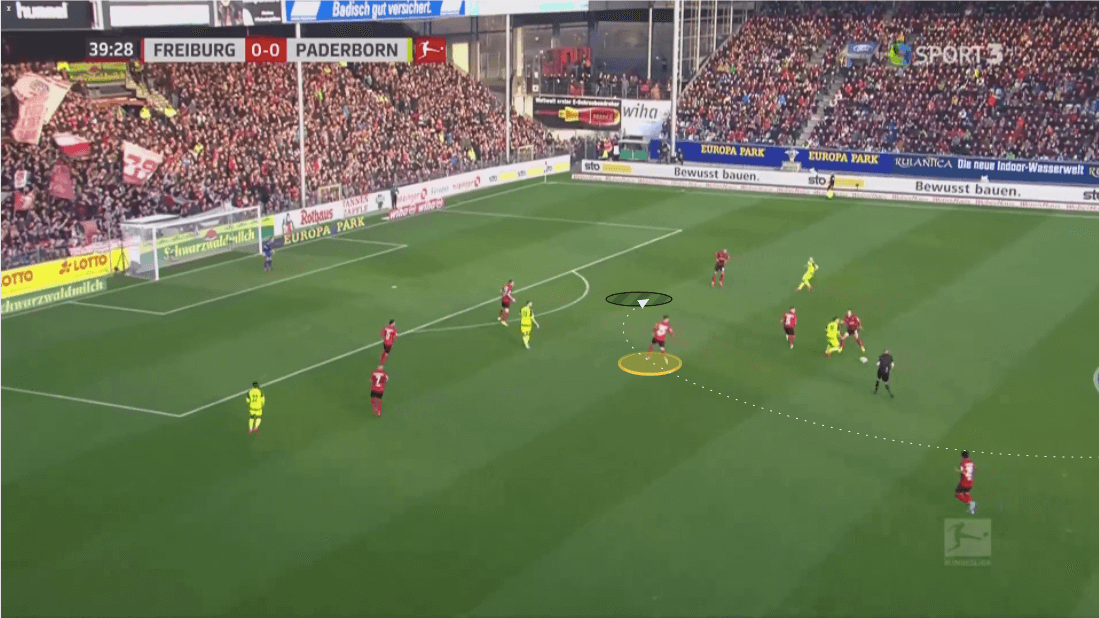
In possession
Koch is incredibly composed on the ball, and is a truly outstanding passer, with an excellent range. He is both footed and can play as a left-sided centre-back; however, for difficult forward passes, he will generally use his right foot. During build-up play, we often see Freiburg use Koch as the anchor, where his passing range makes him the perfect candidate to aid ball circulation. When he has the ball in these areas, he will look to hit any players in wide and high areas, who have enough space to receive.
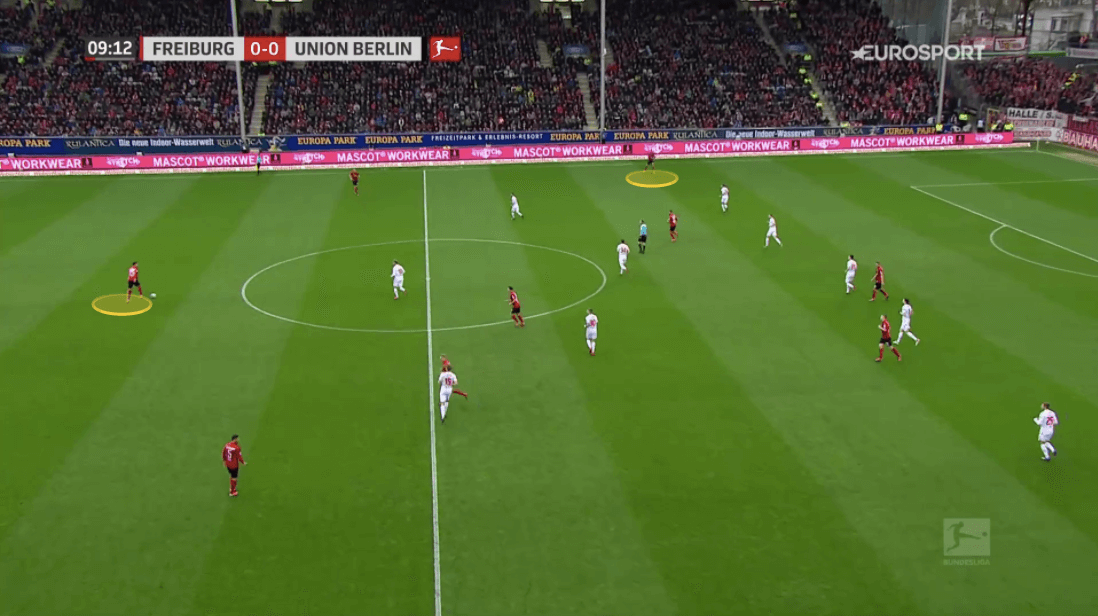
So often we see Freiburg focus their build-up play on one side of the pitch, creating a heavy imbalance in their formation on that side, whilst leaving a full-back or winger out by themselves on the other flank. Koch is so often positioned in this position to receive the ball back should there be no way through, and to quickly switch play in order to start an attack, and create a one v one situation on the other flank. The red zone in the heat map below highlights how he sits in this deep area below the centre-circle and works as this anchor in the backline.

He is vital in everything that Freiburg do in possession and is so often at the start of any attack stemming from the back for them. Against Augsburg, Freiburg managed a total of 540 successful passes with 99 of these coming just from Koch at a pass accuracy of 93%. The pass map below shows his impact on this game. We can see by looking at this image the large amount of lateral passes Koch was involved in, and as mentioned above, he is constantly used to switch the play, even if that is just a lateral pass to his centre-back partner. However, it’s important to note the forward passes, and particularly the locations of some of these. From his two key passes, we can see that he has the ability to successfully penetrate the 18-yard box either from inside his own half, or from a relatively advanced position for a centre-back, comfortably inside the opposition half.

Passes aren’t played laterally just for the sake of it, and he does truly look to play forwards before playing laterally, but keeping possession is at the forefront if he can’t directly create or facilitate an attacking opportunity. As soon as he plays a lateral pass, he will look to receive once more. Below we see him drop off instantly after playing to left-back Christian Günter, creating space centrally for his midfielders.
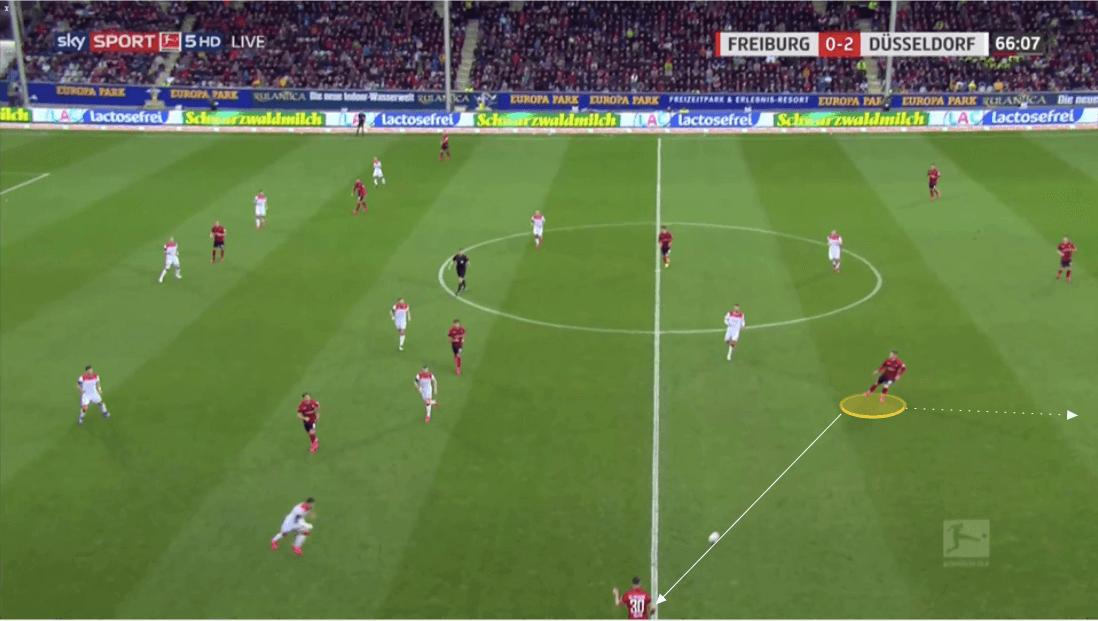
He will play lateral passes to create better forward passing options for himself, and there are times where you can see he is working two or three passes ahead in his mind with his decision-making. Below he has an interchange with Günter, inviting the press towards him, creating space for the pivot beyond. He also highlights his skill and comfort on the ball, feigning to square the ball but instead playing inside through the small gap, past the onrushing Köln forward Córdoba, to hit his pivot.
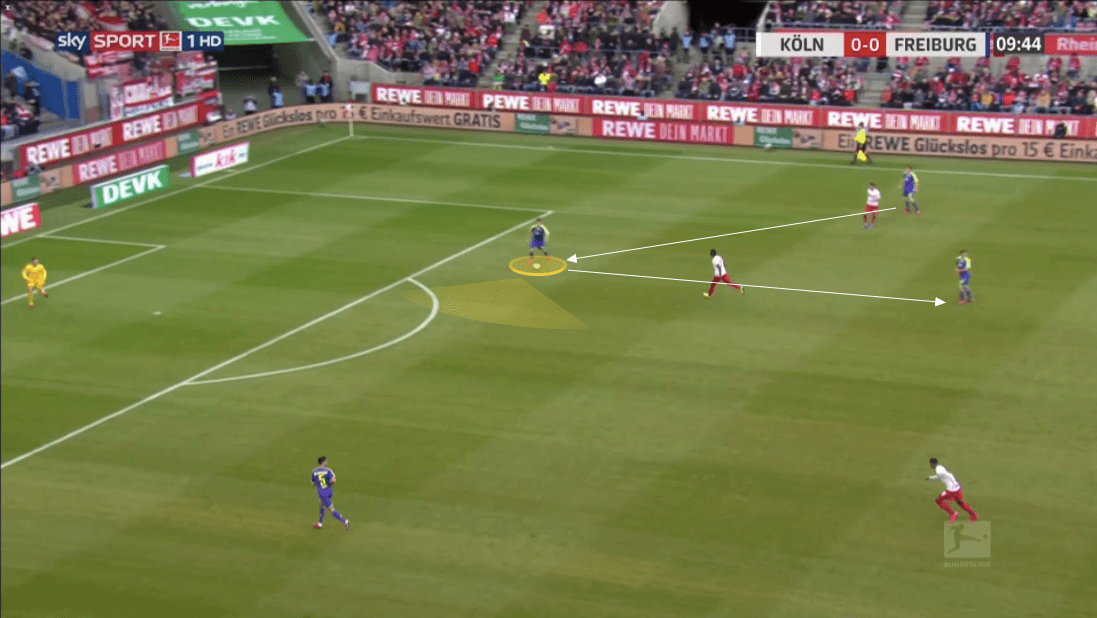
However, using the pivot can take away a lot of what Koch offers in position, and typically they will be used more to occupy space, bring the opposition forward, and open passing lanes to players in more attacking areas. Koch will often look to bypass the pivot and play forward whenever possible. For all of his ability as a long ball passer, he is just as adept threading passes along the floor through the smallest of gaps.
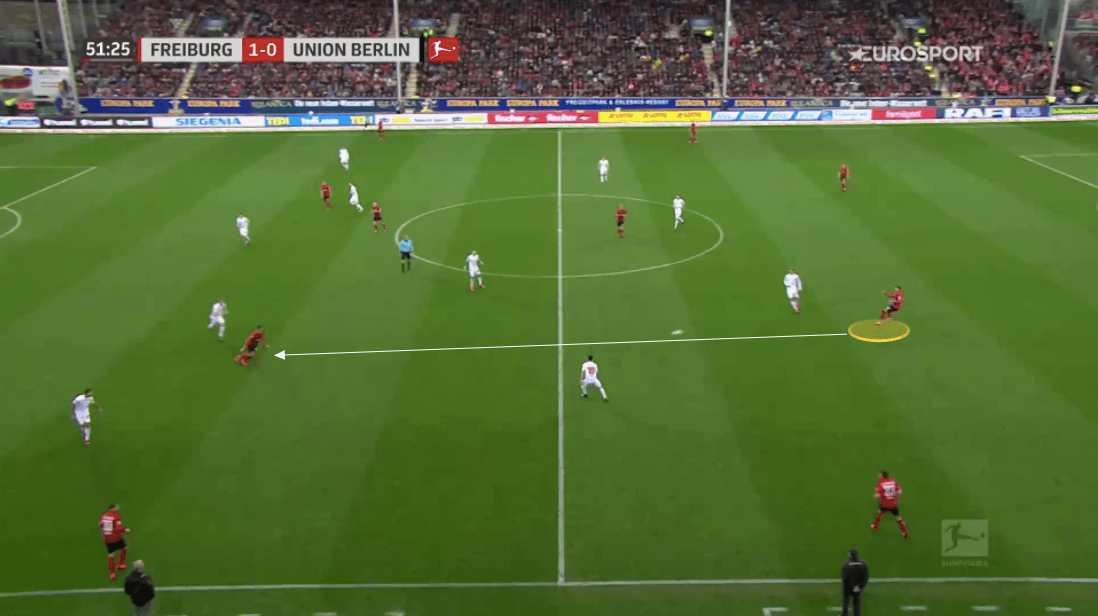
We can see another example of him doing exactly this in the image below too as he missed out the pivot to hit the more advanced midfielder. What this image really shows, however, is Koch’s confidence in hitting these kinds of passes regardless of the positioning of the defenders. In this specific example below, he hits the ball directly across the feet of the Köln attacker and into the feet of a teammate sandwiched between two opposition midfielders.
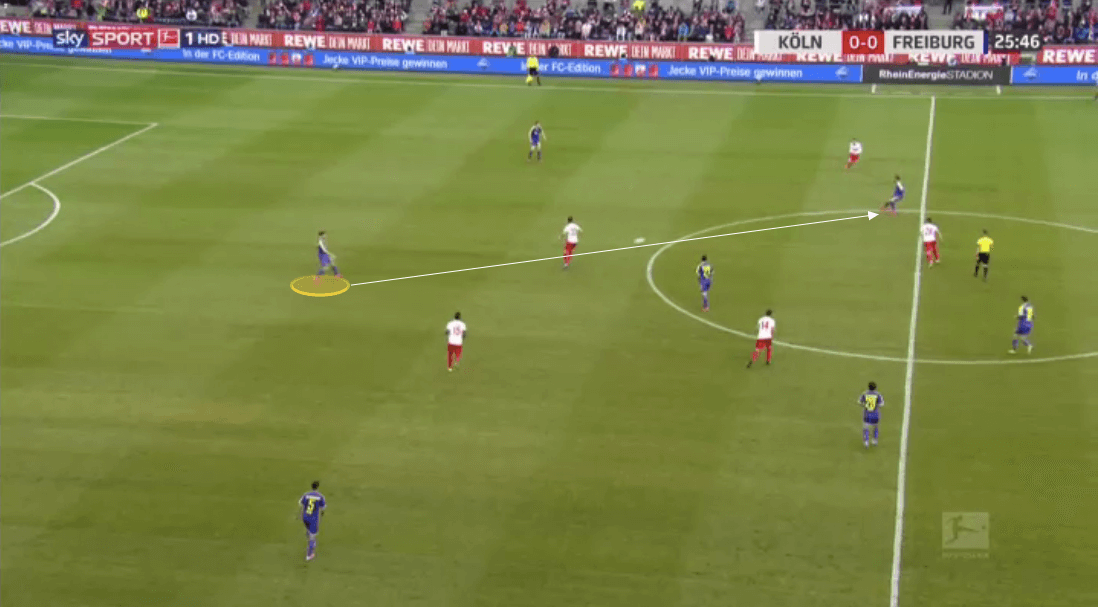
Long passing ability
Koch’s greatest talent may well lie in his long passing range, which is truly of the highest level. It’s not just his ability to pick out players with long diagonal passes on the opposite flank, but the speed at which he sees these opportunities. Rarely is there a hesitation as he goes to play these passes, and if there is one, it is often to change to a different option and a different angle at the last moment.
If we compare the best centre-backs in the league under the age of 23 (who have played more than 450 minutes this season), for passing distance, and total passing accuracy, we can see by looking at the graph below that Koch is quite the talent. Along with his Freiburg teammate Philipp Lienhart, and Köln centre-back Sebastiaan Bornauw, his average pass distance is over 42 metres per pass, yet despite this, he averages slightly under 89% on pass accuracy.

When we discuss range, it’s easy to instantly think of how far a person can pass a ball. There’s of course more to range than just that, and this certainly applies to Koch. His ability to vary the trajectory and pace on his passes is excellent and to read the situation and play the type of pass needed too. When the opposition defence is more set, with the side in a good defensive formation, and little space in between, behind, or in front of the defenders Koch is still able to pick out attacking options. He can accurately place long passes hit with pace and a lower trajectory. Obviously this is to get it to its target quicker, but where a lofted pass in this scenario is easier for a deep defence to deal with, the flatter trajectory presents a different challenge.
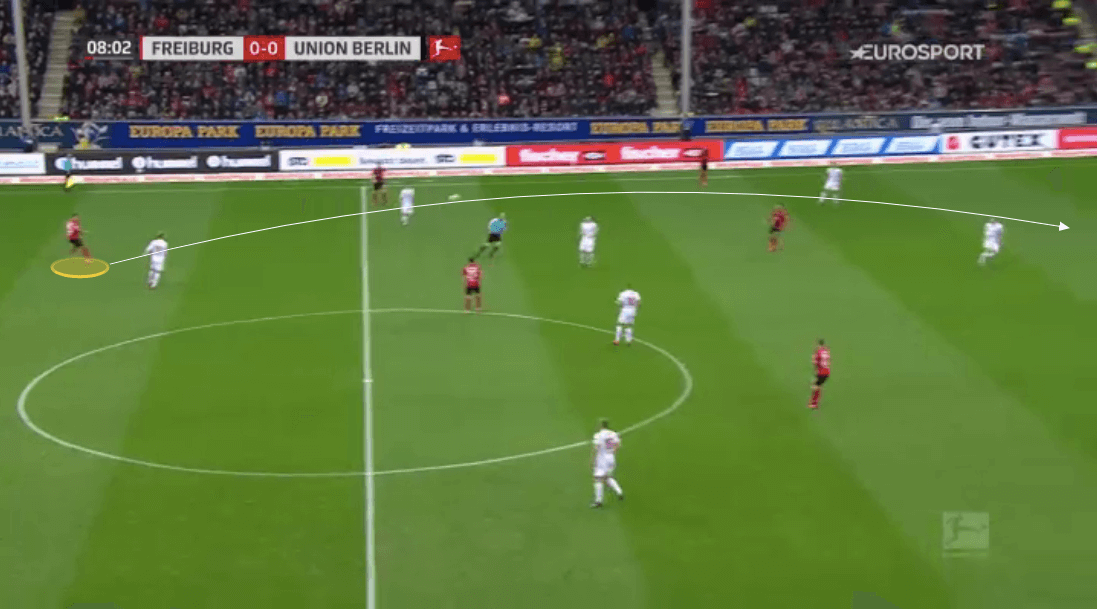
This isn’t something he does every time, and he uses it sparingly, yet it is noticeable when he plays these kinds of passes, and how well he plays them, what a talent he is on the ball. Otherwise, he can still play well-placed lofted passes from centre-back to either flank, and is able to comfortably beat the full-backs with these kinds of passes on a regular basis. Either that or he will use his terrific vision to play in the forward line over the top.
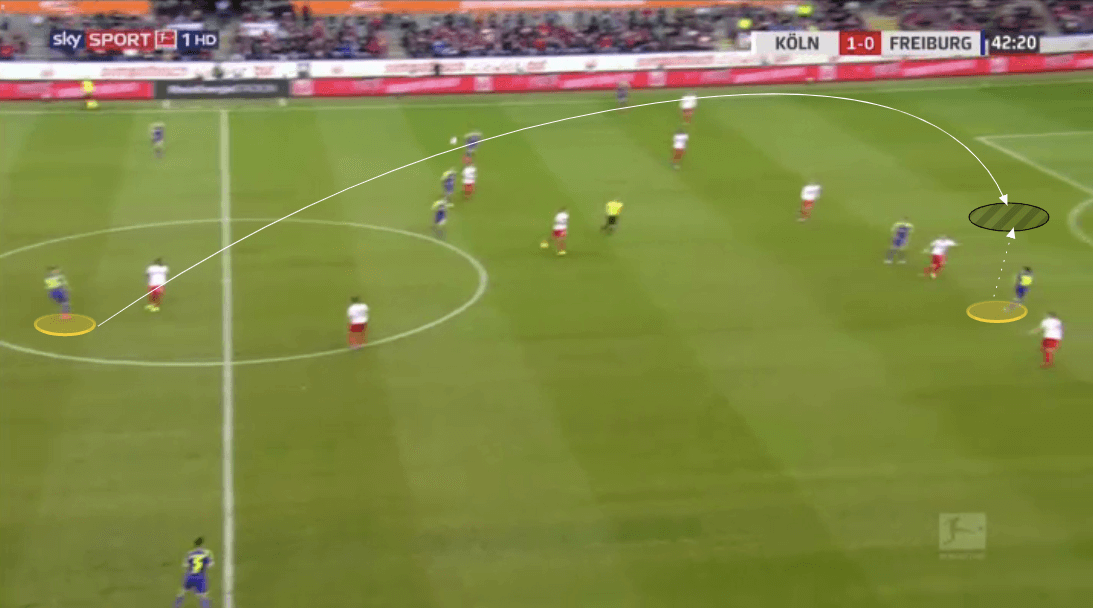
Conclusion
Whether or not a team comes in for Koch this summer remains to be seen, however, he would be a suitable addition to any side looking to bolster their squad with Koch being more than adept in two key positions.

This scout report has highlighted his excellent passing ability, whilst also showed that for all of his on-ball skill, he is an equally robust and talented defender in many aspects as the radar above suggests.





Comments